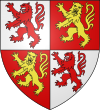Princesses of Orange
House of Baux
| Picture | Name | Father | Birth | Marriage | Became Princess | Ceased to be Princess | Death | Spouse |
|---|---|---|---|---|---|---|---|---|
 | Tibors de Sarenom | Guilhem | 1130 | after 5 June 1156 | 1171 husband's accession | 1181 husband's death | after 13 August 1198 | Bertrand I |
| Ermengarde de Mévouillon | Mévouillon | 1130 | after 5 June 1156 | 1181 husband's accession | 21 March 1203 divorce | ? | William I | |
| Alix | Unknown | ? | after 1203 | 1218, before 30 July husband's death | 1219? | |||
 | Malberjone of Aix | Aix | ? | 17 June 1239 | ? | ? | Raymond I | |
 | Eleonore of Geneva | Geneva | ? | 1273 | 1282 husband's accession | 1314 husband's death | ? | Bertrand II |
 | Anne de Viennois | Viennois-de la Tour-du-Pin | ? | before 31 January 1318 | 1340 husband's death | after 27 November 1357 | Raymond II | |
| Constance of Trian | Trian | ? | ? | 1340 husband's death | before 1358 | Raymond III | ||
 | Jeanne of Geneva | Geneva | ? | 12 April 1358 | before 15 February 1389 | |||
House of Châlon-Arlay
| Picture | Name | Father | Birth | Marriage | Became Princess | Ceased to be Princess | Death | Spouse |
|---|---|---|---|---|---|---|---|---|
 | Joanna of Montfaucon | Henri of Montbéliard, Lady of Montfaucon (Montfaucon) | - | April 1418 | October 1417 husband's accession | 14 May 1445 | Louis I | |
 | Eléonore of Armagnac | John IV, Count of Armagnac (Armagnac) | 1423 | 26 September 1446 | 6/11 December 1456 | |||
 | Blanche of Gamaches | Guillaume, Lord of Gamaches (Gamaches) | - | - | 3 December 1463 husband's death | 23 May 1479 | ||
 | Catherine of Brittany | Richard, Count of Étampes (Montfort) | 1428 | 19 August 1438 | 3 December 1463 husband's accession | 27 September 1475 husband's death | before 22 Abril 1476 | William II |
 | Joanna of Bourbon | Charles I, Duke of Bourbon (Bourbon) | 1442 | 21 October 1467 | 27 September 1475 husband's accession | 1493 | John II | |
 | Philiberta of Luxembourg | Antoine de Luxembourg, Count of Ligny (Luxemburg-Ligny) | - | January 1494 | 15 April 1502 husband's death | May 1539 | ||
House of Nassau
| Picture | Name | Father | Birth | Marriage | Became Princess | Ceased to be Princess | Death | Spouse |
|---|---|---|---|---|---|---|---|---|
 | Anna of Lorraine | Antoine, Duke of Lorraine (Lorraine) | 25 July 1522 | 22 August 1540 | 15 July 1544 husband's death | 15 May 1568 | René | |
House of Orange-Nassau
| Picture | Name | Father | Birth | Marriage | Became Princess | Ceased to be Princess | Death | Spouse |
|---|---|---|---|---|---|---|---|---|
 | Anna van Egmont | Maximiliaan van Egmond (Egmond) | March 1533 | 6 July 1551 | 24 March 1558 | William I | ||
 | Anna of Saxony | Maurice, Elector of Saxony (Wettin) | 23 December 1544 | 25 August 1561 | 22 March 1571 marriage annulled | 18 December 1577 | ||
 | Charlotte of Bourbon | Louis, Duke of Montpensier (Bourbon-Montpensier) | 1546/7 | 24 June 1575 | 5 May 1582 | |||
 | Louise de Coligny | Gaspard II de Coligny (Coligny) | 23 September 1555 | 24 April 1583 | 10 July 1584 husband's death | 13 November 1620 | ||
 | Eleonora of Bourbon-Condé | Henri I, Prince of Condé (Bourbon-Condé) | 30 April 1587 | 23 November 1606 | 20 February 1618 husband's death | 20 January 1619 | Philip William | |
 | Amalia of Solms-Braunfels | John Albert I, Count of Solms-Braunfels (Solms-Braunfels) | 31 August 1602 | 4 April 1625 | 23 April 1625 husband's accession | 14 March 1647 husband's death | 8 September 1675 | Frederick Henry |
 | Mary Henrietta of England | Charles I of England (Stuart) | 4 November 1631 | 2 May 1641 | 14 March 1647 husband's accession | 6 November 1650 husband's death | 4 December 1660 | William II |
 | Mary of England | James II of England (Stuart) | 30 April 1662 | 4 November 1677 | 28 December 1694 | William III | ||



















